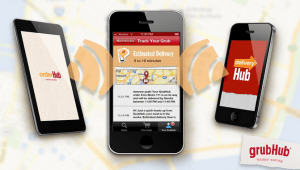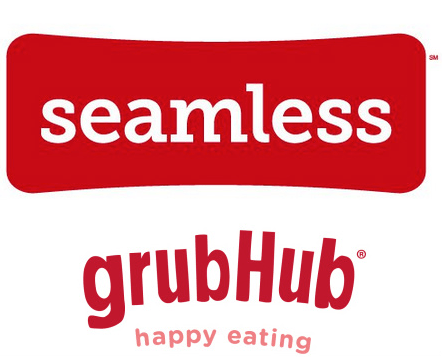Today, thanks to the maturation of the web, digital tech, and smartphones now in seemingly every pocket, startups are finding it easier than ever before to build scalable solutions to finally address the many inefficiencies in our food manufacturing, production and distribution systems.
As interest in food tech balloons, one area in particular already appears to be at the tipping point: Online and mobile food delivery. Over the last few days, we’ve been hearing about a merger between two of the largest companies in the space. Rumor has it that “arch rivals” GrubHub and Seamless are in talks which could see them join forces as part of a merger. While our sources tell us that the talks are serious, the terms of the merger are not yet clear and, of course, any potential deal could fall through.
[The GrubHub-Seamless merger was officially announced by the companies this morning, confirming most of what we’d been hearing in advance. For more details, read our follow up post here.]
Furthermore, it’s not yet clear what kind of synergies would take place, how management of the new entity would be structured or even what the new business will be called. The two companies would not confirm on the record on any of the above. But as far as the name goes, we’re hoping for Grubless. Or Hubless GrubSeam. But they have a nice ring to them, don’t they?
If these rumors are true, the merger comes at a good time for the arch rivals, who have been seeing mounting competition of late from a laundry list of new startups entering the space, including increasingly popular alternatives like Delivery.com, ChowNow, Munchery (meals from local chefs), Campus Special, eat24 or the bigs of Europe, like Delivery Hero and Just-Eat.
If the online food-ordering and delivery market is roughly where daily deals were three-plus years ago, then the deal essentially creates the Groupon of food delivery. And like the daily deals market, food ordering has traditionally had a fairly low barrier to entry, which helps explain why we seem to see a new startup pop up in this space every week.
Plus, the business model isn’t particularly complicated, which makes it replicable. That being said, the food industry has been slow to innovate and adopt new technologies over the years, leaving plenty of room for disruption. Especially in mobile. For any business, scaling is an expensive proposition (requiring tons of investment), and often becomes a profit-busting necessity as a result.
However, once the online food ordering business model scales, it has the potential to generate a lot of cash (from taking a fixed slice of every transaction). So, if the merger between GrubHub and Seamless is about growth rather than cutting costs (or corners), then scale helps explain it. Together, the companies will be in over 500 cities, and that definitely counts as scale.
The high margins at scale (in certain verticals within the industry, mind) are part of the reason why the “food tech” market has been so hot lately. Just ask venture capitalists, who collectively poured $350 million into food startups over the last year. (Compared to 2008, when investment in food was less than $50 million.) Plus, when you get right down to it: People need to eat. And, as it turns out, people are pretty busy. Uh, and lazy.
 Of course, for those who remember the spectacular failure of online food companies like Webvan, Kozmo and HomeRuns, this whole “tech in your kitchen” and online ordering jibber-jabber probably sounds familiar — and not in a good way. But this time it’s different. Research from Cornell University recently found, for example, that over 40 percent of adults in the U.S. have ordered food online, and 10 percent of restaurant orders now originate online — and these numbers continue to head north. GrubHub and Seamless have built successful businesses on this very concept.
Of course, for those who remember the spectacular failure of online food companies like Webvan, Kozmo and HomeRuns, this whole “tech in your kitchen” and online ordering jibber-jabber probably sounds familiar — and not in a good way. But this time it’s different. Research from Cornell University recently found, for example, that over 40 percent of adults in the U.S. have ordered food online, and 10 percent of restaurant orders now originate online — and these numbers continue to head north. GrubHub and Seamless have built successful businesses on this very concept.
As to the motivation for the merger, while both companies have been around for some time — the New York City-based Seamless was founded in 1999, while the Chicago-based GrubHub got its start in 2004 — historically they have catered to two different markets geographically. GrubHub developed a firm foothold in the Midwest, while Seamless focused its early attention on NYC, before moving into cities like Los Angeles and San Francisco, for example. From that perspective, a merger would make sense, allowing the new, consolidated entity to gain entry into markets where they lacked a major presence through the other.
Writ large, while having some fundamental differences, the companies do seem to have a lot of synergies on paper — at least “nominally,” depending on who you ask — likely why they’ve seen increasing overlap in their businesses over recent years. Both companies are of fairly comparable size, as GrubHub has more than 20,000 restaurant partners across more than 500 cities, while Seamless has over 12,000 restaurants and serves nearly 5,000 businesses and more than 2 million users. As of February, Reuters reported that Seamless was on track to generate more than $100 million in revenue this year, as it expands into new cities and focuses more aggressively on mobile.
The company reportedly generated $85 million in revenue last year, growing its consumer business by 60 percent year-over-year and “will soon be processing $1 billion worth of food orders a year,” Seamless CEO Jonathan Zabusky told Reuters at the time. For the majority of its history, the company focused primarily on New York, but launched a major expansion effort last year, bringing its service to 10 new cities. According to the report, Seamless saw its transaction volume quadruple in Los Angeles during 2012, with transactions tripling in San Francisco.
Another interesting point to note: GrubHub was reported to be considering an IPO last fall. The company denied the rumors at the time, and if this merger is true, then they’ve been given the proper perspective. Certainly, it would seem that this wouldn’t take a potential IPO off the table, instead, likely making an opening price that much higher.
The IPO rumors for GrubHub came at a time when the company was reportedly doing about $60 million in revenue (this was in 2012) — a little less than half that of Seamless. Furthermore, Crain’s reported in December that GrubHub’s revenue has been doubling every year and, as the company reported $30 million in revenue in 2011, that revenue estimate would make sense and put the company on the path to crossing $100 million well before the end of this year.
 That is all to say that, although the terms of the potential deal are unclear, these are two sizable businesses that are growing relatively fast, so any potential valuation has got to be fairly high. After all: The two companies were fairly comparably capitalized and staffed, with GrubHub growing to over 350 employees and Seamless over 300, while GrubHub raised about $84.1 million from a mix of venture and growth equity firms (including Benchmark, Origin and Amicus) and Seamless raised $51 million, $50 million of which came from private equity firm Spectrum Equity.
That is all to say that, although the terms of the potential deal are unclear, these are two sizable businesses that are growing relatively fast, so any potential valuation has got to be fairly high. After all: The two companies were fairly comparably capitalized and staffed, with GrubHub growing to over 350 employees and Seamless over 300, while GrubHub raised about $84.1 million from a mix of venture and growth equity firms (including Benchmark, Origin and Amicus) and Seamless raised $51 million, $50 million of which came from private equity firm Spectrum Equity.
While both companies have made a couple of acquisitions, this would be the second big M&A deal for Seamless, as the company was acquired by food services giant, ARAMARK, in 2006. Five years later, Spectrum bought a minority stake in Seamless from ARAMARK, and about a year later, the food services company spun-off its remaining interest in Seamless to its shareholders. Free from its corporate ownership, Seamless proceeded to go out and buy MenuPages for $15 million, showing up GrubHub, which MenuPages had initially targeted as its acquirer. When GrubHub and MenuPages couldn’t agree to a deal, and it seems that GrubHub was instead in the process of buying Dotmenu/Allmenus, Seamless swooped in — according to BetaBeat.
So, as you can see, the companies have a long history of jostling. While GrubHub had been out acquiring restaurant partners fast and furiously, Seamless stagnated a bit under ARAMARK, but since becoming an independent company (again) and with a new board/investors, the company seems to have been compounding its growth. Together, that growth could be exponentially higher.
Finally, if this deal is in fact a go, it’s worth looking at this quote from GrubHub co-founder and CEO Matt Maloney from back in 2011. In it, he shares his opinion on GrubHub’s top competitor, a little company called Seamless. He told BetaBeat:
I typically don’t talk this much about Seamless because we don’t view them as incredibly strong competition for what we’re doing … Seamless fundamentally is a corporate catering business. They were founded years and years and years ago to do just that. And they’re still best in the business for corporate. They recently got into the consumer and residential pick-up and delivery. And they do it well in New York, but they really have zero business anywhere else. We don’t even consider them competition anywhere other than Manhattan specifically.
So, there you go. A match potentially made in heaven, and one that’s sure to shake up online and mobile food ordering if it happens.
Find Seamless at home here and GrubHub here.
